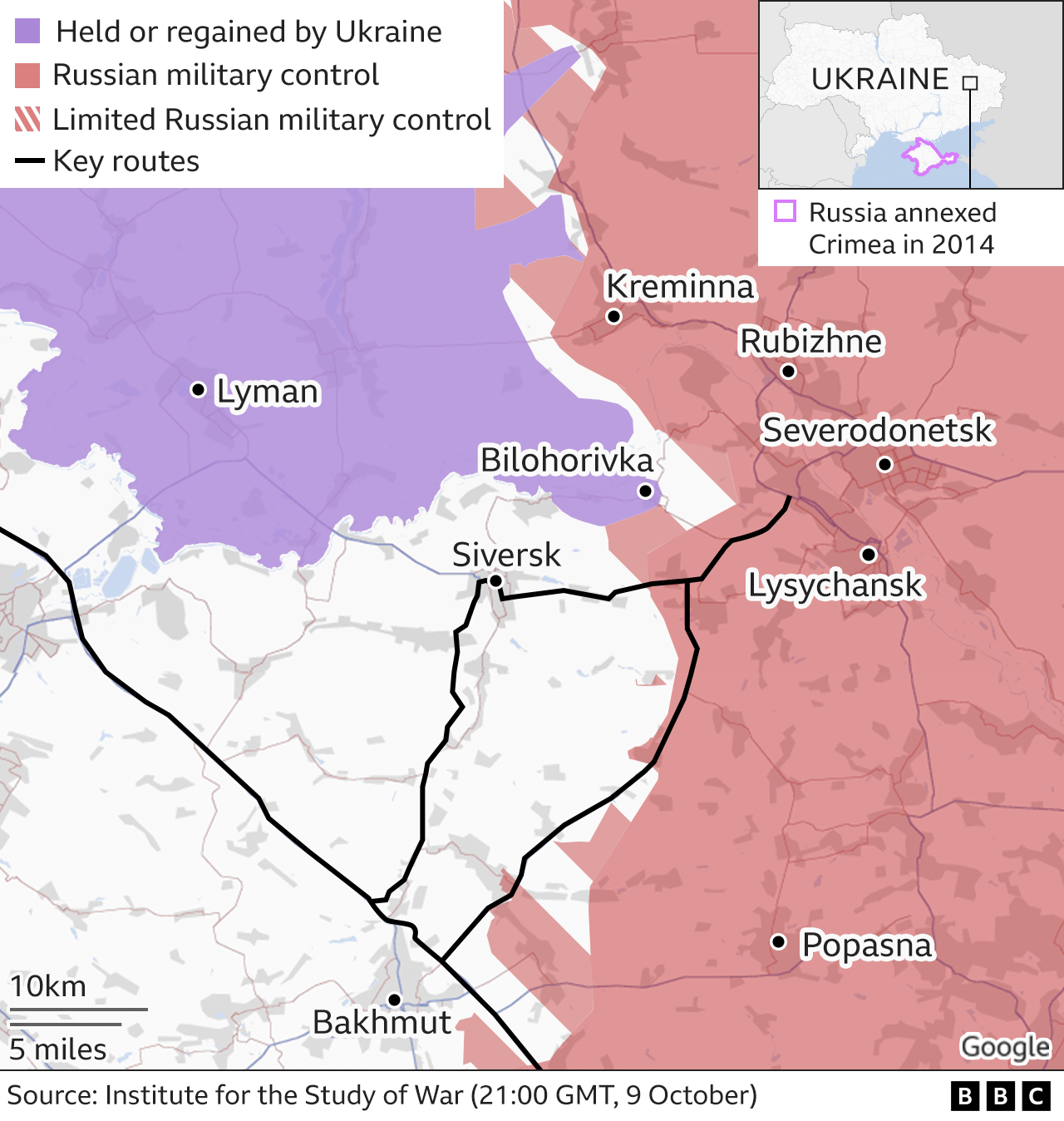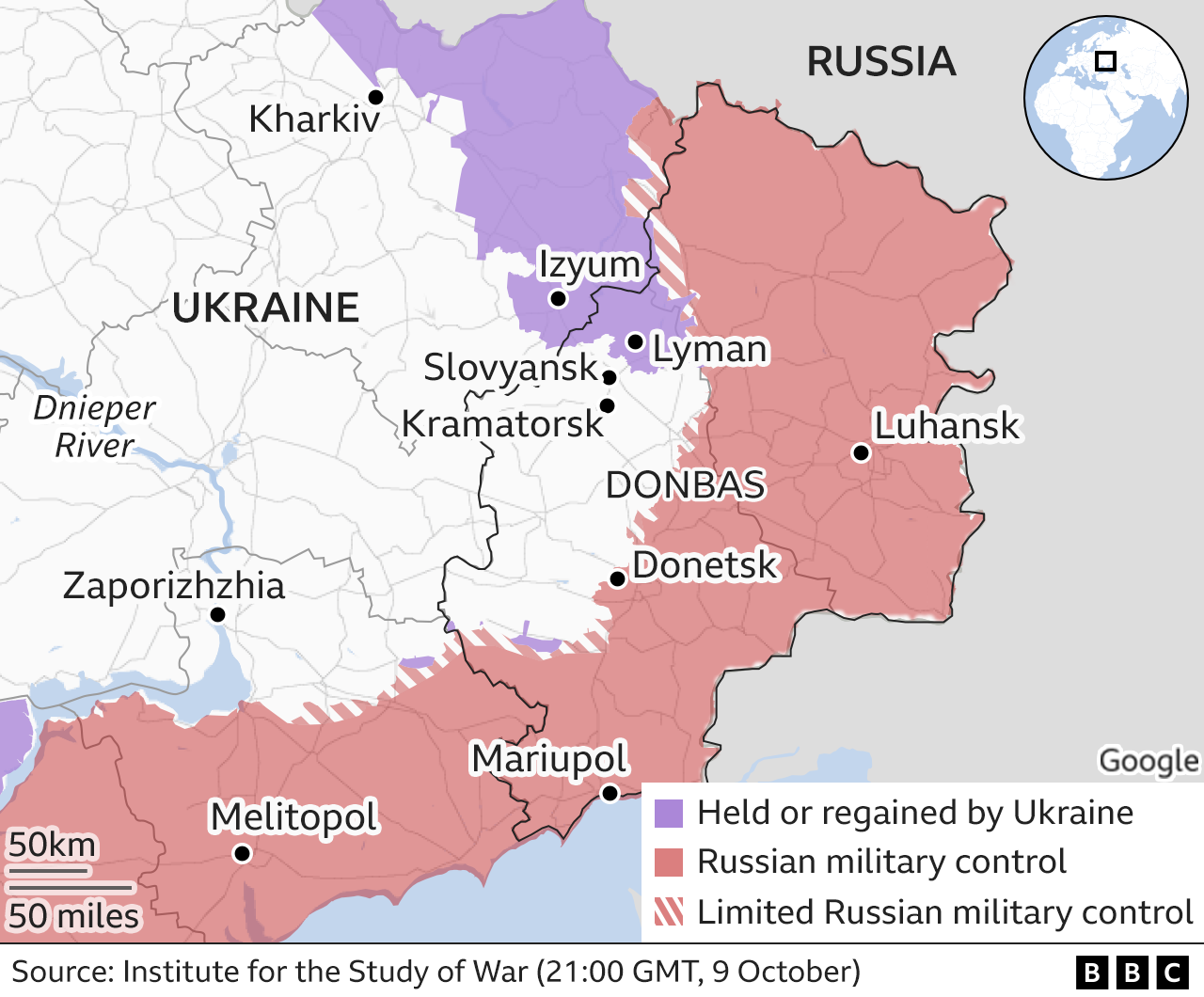Two days after the only bridge connecting Russia with the annexed Crimea was broken in an explosion, Russia fired missiles at various Ukrainian cities, including Kyiv.
Here are the latest developments:
- Missile strikes have been reported in cities including Kyiv, Lviv, Dnipro, and Zaporizhzhia, in what appears to be the most widespread set of Russian attacks since the early weeks of the war
- Russia has partially reopened the bridge linking it to Crimea, which is an important supply route for Russian forces fighting in Ukraine
- Ukrainian troops have continued to progress after breaking through Russian defences in the southern Kherson region
- In Donetsk, Ukrainian forces are pushing east, having taken the town of Lyman
Ukrainian cities hit in missile strikes
At least 12 Ukrainian cities have been hit in missile strikes two days after a strategically important bridge linking Russia with Crimea was damaged in a blast.
Kyiv has been targeted for the first time in months, but explosions have also been reported in Ternopil and Lviv in the west, which has so far escaped the worst of the war.
Ukraine’s President Volodymyr Zelensky says Russia has targeted energy infrastructure across the country and that energy facilities in Kyiv, Lviv, Dnipro, Vinnytsia, Zaporizhzhia, and Kharkiv are among the places hit.
Ukraine’s military commander says Russia launched 83 missiles in total.
It comes a day after Russian President Vladimir Putin accused Ukraine’s security services of attacking the Kerch bridge – although Ukrainian officials have not indicated whether their forces were behind the attack.
The 19km (12-mile) bridge, the longest in Europe, is an important supply route for Russian forces fighting in Ukraine.
Russia has used the bridge to move military equipment, ammunition, and personnel from Russia to battlefields in southern Ukraine.

Mr Putin described the blast as an “an act of terrorism aimed at destroying Russia’s critical civilian infrastructure”.
Russian authorities partially reopened the roadway part of the bridge hours after the attack but for light traffic only.
The railway part of the bridge – where oil tankers caught fire – has also reopened.
Ukrainian breakthrough in the south
Ukrainian troops have continued to advance after breaking through Russia’s defences on the west bank of the Dnieper River in Kherson.
They have retaken the village of Dudchany and the Institute for the Study of War (ISW) says Ukrainian sources report that Russian occupation authorities are moving their families from the Kherson region to Crimea.

Ukrainian troops have been attacking bridges, ferries and pontoons in recent weeks, attempting to make Russian positions on the west side of the river unsustainable, and thereby force a withdrawal.
Also in the south, the International Atomic Energy Agency (IAEA) has called for the demilitarisation of the Zaporizhzhia nuclear power plant.
Russian and Ukrainian sources have accused each other of shelling close to the plant, which is Europe’s biggest nuclear facility.

Russia’s military took over the power station in early March, but it is still being operated by Ukrainian staff.
Intense fighting in the east
Ukrainian troops took control of the key logistical hub of Lyman in Donetsk more than a week ago and have continued to push further east towards the region of Luhansk.

The ISW says they have “made substantial gains” in the area.
Russian reports suggests their next target may be the city of Kreminna.
Analysts say the loss of Lyman is a major set-back for Russia.
Russian forces have been trying to push forward in Bakhmut, but reports suggest they have been repelled by Ukrainian troops.

The latest fighting follows a major Russian defeat in the east.
Ukraine says it recaptured 6,000 sq km (2,317 sq miles) of territory from Russia in early September, when it forced back Russian units in the Kharkiv region.
Russian troops withdrew from the key towns of Izyum and Kupiansk, saying that the retreat would allow its troops to “regroup”.
Both towns were major logistical hubs for Russian forces in Donbas.
Annexation of four regions
Four regions of Ukraine, that are partially or almost completely occupied by Russia are being annexed by the Russian Federation.
It follows self-styled referendums in Donetsk, Luhansk, Kherson and Zaporizhzhia, held between 23 and 27 September.

President Vladimir Putin has said that Russia will use “all the forces and resources” it has to “liberate” the four regions.
In an address to the Russian people, Mr Putin said his country had “various weapons of destruction”, adding: “I’m not bluffing.”
The annexations follow a “partial mobilisation” of about 300,000 Russian reservists.
Russia invaded Ukraine on 24 February, but Ukrainian forces retook large areas around Kyiv in early April after Russia abandoned its push towards the capital.
Areas in the west of the country, including Lviv, have seen missile attacks but no attempt by Russian forces to take and occupy ground.
The Russians have suffered heavy losses since the invasion began and significant quantities of Russian weaponry have also been destroyed or captured.
